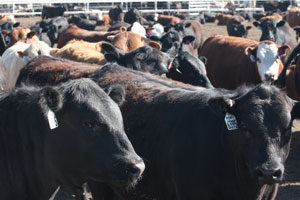Moreover, high proportions of current feedlot marketings are feeders placed at light weights which should also imply lighter finishing weights.
There are several factors affecting these apparent inconsistencies.
The first thing to keep in mind is that we usually compare things to last year and things have been anything but normal for many months. For the coming months especially, the year ago values that we will be comparing to were greatly impacted by the drought so that the comparisons will be harder to interpret.
Moreover, there are a variety of short term, medium term and long term factors that are influencing slaughter and carcass weight data in a variety of ways.
Federally inspected cattle slaughter for the year to date is down 4.8 percent, however, feedlot marketings are down less than one percent for the year.
The first thing is to account for the various slaughter classes. Cow slaughter has averaged about 17.6 percent of total slaughter since the mid-1980s. For the last four years, cow slaughter has made up 19 percent of total slaughter and in 2011, cow slaughter represented 20 percent of cattle slaughter.
Cow slaughter will decrease this year, both in absolute terms and as a percent of total slaughter. For the year to date, cow slaughter is down 3.5 percent, despite the fact that dairy cow slaughter is up over 2 percent.
Beef cow slaughter is falling and will fall dramatically in coming months compared to last year’s drought elevated levels. Beef cow slaughter is down 8.6 percent for the year to date but down a more dramatic 17.4 percent in the last six weeks.
Another puzzle is the relationship between feedlot marketings and yearling slaughter data. Through April, combined steer and heifer slaughter is down 4.4 percent but feedlot marketings for the same period were down less than one percent.
The data increasingly imply structural change in the cattle feeding industry.
For a number of years, fed marketings from feedlots over 1,000 head capacity have averaged about 85 percent of yearling slaughter, meaning that roughly 15 percent of fed steer and heifer slaughter was originating from small feedlots.
Over the past nine months, this proportion has increased to over 87 percent, implying that more of the small feedlots are exiting and a higher proportion of yearling slaughter is coming from larger feedlots.
So far in 2012, beef production is down 2.9 percent as reduced slaughter has been partially offset by larger carcass weights. As with slaughter data, understanding carcass weights means looking beyond the average cattle carcass weights into the contribution of various classes of cattle in the slaughter mix.
Cattle carcass weights have averaged 19 pounds heavier than last year and are currently 22 pounds above this same time last year.
There are several reasons for the heavier carcass weights. First, carcass weights are being compared to one year ago when cows made up the largest proportion of total slaughter in 25 years. Moreover, cow slaughter in 2011 included higher proportions of beef cows which have the lightest carcass weights.
Reduced cow slaughter in 2012, along with fewer beef cow as a proportion of cow slaughter will help hold up average cattle carcass weights.
Yearling carcass weights are also higher than last year, perhaps due in part to favorable weather conditions through the winter but also due to increasingly widespread use of beta agonist products in finishing. Beta agonists are fed at the end of the feedlot finishing phase and add additional weight that is no doubt pushing carcass weights higher.
Moving into the second half of the year, cow slaughter is expected to continue declining and yearling slaughter will begin to drop more sharply in the third quarter.
Carcass weights are likely to stay above year ago levels but not enough to prevent beef production from falling.
Overall, beef production is expected to end the year down more than 3 percent from 2011 levels.
—From Cow/Calf Corner
PHOTO
Staff photo.









